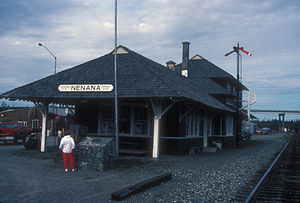
Nenana (Lower Tanana: Toghotili; is a home rule city in the Yukon-Koyukuk Census Area of the Unorganized Borough in the Interior of the U.S. state of Alaska. Nenana developed as a Lower Tanana community at the confluence where the tributary Nenana River enters the Tanana. The population was 378 at the 2010 census, down from 402 in 2000.

The Alaska Railroad is a Class II railroad that operates freight and passenger trains in the state of Alaska. The railroad's mainline runs between Seward on the southern coast and Fairbanks, near the center of the state. It passes through Anchorage and Denali National Park, to which 17% of visitors travel by train.

Klondike Gold Rush National Historical Park is a national historical park operated by the National Park Service that seeks to commemorate the Klondike Gold Rush of the late 1890s. Though the gold fields that were the ultimate goal of the stampeders lay in the Yukon Territory, the park comprises staging areas for the trek there and the routes leading in its direction. There are four units, including three in Municipality of Skagway Borough, Alaska and a fourth in the Pioneer Square National Historic District in Seattle, Washington.
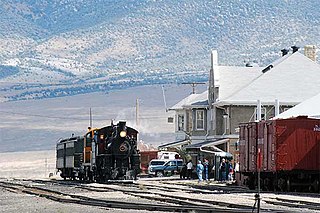
The Nevada Northern Railway Museum is a railroad museum and heritage railroad located in Ely, Nevada, owned by the State of Nevada and operated by a historic foundation dedicated to the preservation of the Nevada Northern Railway.

Ladd Army Airfield is the military airfield located at Fort Wainwright in Fairbanks, Alaska. It was originally called Fairbanks Air Base, but was renamed Ladd Field on 1 December 1939, in honor of Major Arthur K. Ladd, a pilot in the U.S. Army Air Corps who died in a plane crash near Dale, South Carolina on 13 December 1935.

Claremont station is a passenger rail and bus station in Claremont, California, United States. It is served by Metrolink's San Bernardino Line which runs from Los Angeles Union Station to San Bernardino–Downtown. The Mission Revival-Spanish Colonial Revival style station is listed on the U.S. National Register of Historic Places as Atchison, Topeka and Santa Fe Railroad Station.

Baton Rouge station is a historic train station located at 100 South River Road in downtown Baton Rouge, Louisiana. It was built for the Yazoo and Mississippi Valley Railroad which got absorbed by the Illinois Central Railroad. The station was a stop on the Y&MV main line between Memphis, Tennessee and New Orleans, Louisiana. The building now houses the Louisiana Art and Science Museum.

SS Nenana is a five-deck, western river, sternwheel paddleship. Two-hundred and thirty-seven feet in overall length, with a 42-foot beam, she was rated at 1,000 gross tons register. Nenana was built at Nenana, Alaska, and launched in May 1933. Marine architect W.C. Nickum of Seattle designed the sternwheeler, which was prefabricated in Seattle and put together at Nenana, Alaska, by Berg Shipbuilding Company. Nenana was built to serve as a packet. She could carry both passengers and freight. Nenana had accommodations for 48 passengers on her saloon deck. Up to 300 tons of freight, including two tons in cold storage, could be carried on her main deck. A Texas, topped by a pilothouse mounted forward in poolboat style, provided staterooms for a portion of the crew of 32. Nenana could push five or six barges on the Yukon River; but, because of sharp bends, only one on the Tanana River.
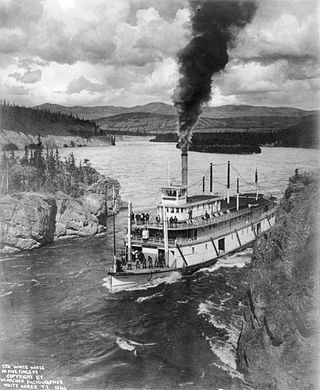
Steamboats on the Yukon River played a role in the development of Alaska and Yukon. Access to the interior of Alaska and Yukon was hindered by large mountains and distance, but the wide Yukon River provided a feasible route. The first steamers on the lower Yukon River were work boats for the Collins Overland Telegraph in 1866 or 1867, with a small steamer called Wilder. The mouth of the Yukon River is far to the west at St. Michael and a journey from Seattle or San Francisco covered some 4,000 miles (6,400 km).

Mayville is a historic train station located at Mayville in Chautauqua County, New York. It was constructed in 1925, for the Pennsylvania Railroad and is a 1+1⁄2-story, brick structure with an overhanging hipped roof. The building measures 117 by 29 feet. The station had were Pennsylvania Railroad trains on a route north to Dunkirk and then to Buffalo. To the south, the routed went to Corry and Oil City and then to Pittsburgh. From the station, travelers to resorts along Chautauqua Lake made connections to interurbans and large fleets of steamboats. The Chautauqua Traction Company served the communities on the western side of the lake; and the Jamestown, Westfield and Northwestern Railroad served the eastern side of the lake.

Anchorage Depot, also known as Alaska Railroad Depot, is the railroad station at the center of the Alaska Railroad system at the junction of the two main lines their trains run on. It serves as the starting point for many tourists traveling on the luxury trains such as the Denali Star. The station is a Moderne-style three story concrete building, built in 1942 and enlarged in 1948.

The Seward Depot, also known as the Seward Station, is a former rail depot in Seward, Alaska, United States.

Butler is a former commuter railroad train station in the borough of Butler, Morris County, New Jersey. Serving passenger and freight trains of the New York, Susquehanna and Western Railway, Butler served as the western terminus of service beginning in 1941, when passenger service was cut from Stroudsburg, Pennsylvania. Trains from Butler operated to Pavonia Terminal in Jersey City until December 12, 1958 and then Susquehanna Transfer in North Bergen until the discontinuation of service on June 30, 1966. Butler station consisted of a single low-level side platform with the wooden frame station. The next station east was Bloomingdale.

The Herndon Depot Museum, also known as the Herndon Historical Society Museum, is located in the town of Herndon in Fairfax County, Virginia. Built in 1857 for the Alexandria, Loudoun & Hampshire Railroad, the depot later served the Richmond and Danville Railroad, the Southern Railway and the Washington and Old Dominion Railroad. In 1875, the original shed was replaced with the current depot.

Sebastopol station was an interurban train station in Sebastopol, California. It was served by the Petaluma and Santa Rosa Railroad and was adjacent to the railway's powerhouse. Official operations ceased in 1932 with the rest of P&SR passenger service. It was leased as retail space for a time before being converted to a museum. The station was added to the National Register of Historic Places in 1996 as Sebastopol Depot of the Petaluma and Santa Rosa Railway .
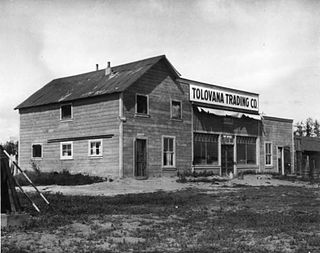
The Tolovana Roadhouse is a historic roadhouse in the Yukon-Koyukuk borough of Alaska. It is located near the confluence of the Tanana and Tolovana Rivers near Nenana, Alaska. Four buildings survive from what was once a more extensive complex of buildings. The extant roadhouse was built in 1924, after both a 1901 roadhouse and 1921 trading post were destroyed by fire. The other three buildings that were in good condition in 1988 included a storage building, outhouse, and power plant; seven other structures were then deemed to be in a state of collapse, while three other documented buildings had been washed away by the erosive force of the Tanana River.

The Louisville and Nashville Depot, located at 101 East Railroad Street in Nashville, Illinois, is the city's former Louisville and Nashville Railroad station. The station was built in 1885 as part of the L&N's expansion through Southern Illinois in the 1880s. The building has a simple vernacular design common to L&N depots in small towns, which were intended to be functional rather than elaborate. The railroad exported the products of Washington County's industries, which included coal, dairy products, grain, and lumber, through the station; it also imported goods such as automobiles, fertilizer, and commercial products. In addition, the railroad provided passenger service to Nashville; at the peak of service, seven daily passenger trains stopped at the depot, and students in other parts of the county used the trains to attend Nashville's high school. The depot also served as an information center for Nashville; the city's telegraph station was located at the depot, and St. Louis daily newspapers arrived by train. The depot remained in service as late as the 1950s but closed sometime prior to 1984.

Cloverdale station is a bus station and future intermodal station in Cloverdale, California. It is served by Amtrak Thruway and Sonoma County Transit buses. Additional service to Sonoma County Airport station is provided by Sonoma County Transit under contract by Sonoma–Marin Area Rail Transit.
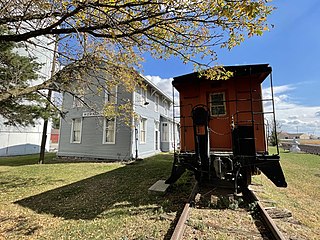
The Chicago, Milwaukee, St. Paul & Pacific Combination Depot-Hornick, also known as the Hornick Depot, is a historic building located in Hornick, Iowa, United States. The town was patted by the Chicago, Milwaukee, St. Paul & Pacific Railroad's land company when the railroad created a branch line from Manilla, Iowa to Sioux City. Completed in 1887, the railroad built this two-story frame structure to serve as its passenger and freight depot. It is one of six such depots that remain in Iowa, and the best preserved. These buildings were built from a standard design used by the railroad. The two-story stations included living quarters for the station manager because the towns had yet to develop when the depot was built. This was an island depot, with freight loaded on the north side and passengers boarded on the south. Decorative elements on this depot include lathe-turned wooden finials, angled wooden brackets, and bracketed door and window hoods. Passenger service ended in the 1950s, and grain was loaded here until 1980 when the Milwaukee Road abandoned the Sioux City branch line. The building was listed on the National Register of Historic Places in 1990. It has been converted into a local history museum.
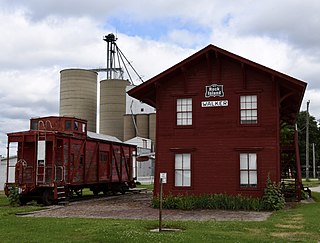
Walker Station is a historic building located in Walker, Iowa, United States. The two-story frame building with bracketed eaves was completed in 1873 along the Burlington, Cedar Rapids, and Minnesota Railway tracks. The depot also served its successor railroads: the Burlington, Cedar Rapids and Northern, and the Chicago, Rock Island and Pacific. Typical of many railroad towns in the Midwest, this is the first building that was built here and the town grew up around it. It is an example of a combination depot that was used for both passenger and freight usage in smaller communities. Because it has a ground level brick platform, service here was primary passenger and light freight service. A higher level of freight service would have required a raised platform.
